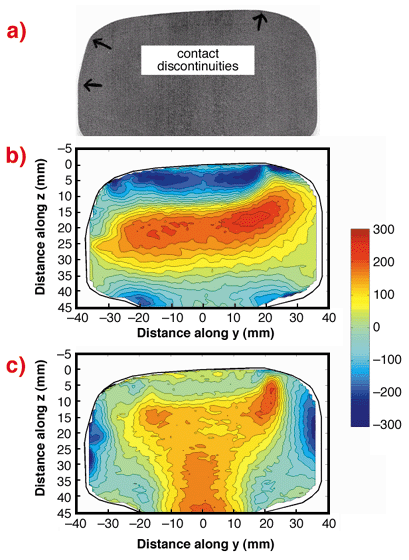- Home
- Users & Science
- Scientific Documentation
- ESRF Highlights
- ESRF Highlights 2002
- Industrial and Applied Research
- Residual Stresses in Railway Rails - The FaME38 Project
Residual Stresses in Railway Rails - The FaME38 Project
A number of serious incidents, including fatal derailments, have been attributed to rail fractures resulting from rolling-contact fatigue cracking. Many of the various mechanisms of rail failure are related to the relationship between defects and the 'residual' stress field in the rail. Typically a rail fracture is the result of a progressive defect, the propagation of which is related to the inherent residual stresses in the rail.
Residual stresses are generated in railway rails first as a result of manufacturing processes. These may include hot-rolling, roller-straightening and head-hardening. Then, in service, the running surfaces of rails are subjected to repeated rolling-contact stresses through contact with the train wheels. These stresses are usually high and they can cause plastic deformation around the contact surface and modify the stress field near the running line and internally in the railhead [1]. There will also be wear caused by sliding friction near the running band and at the gauge corner side of the head when contact is made by the flange, as often happens in curved track. The head of the rail may be ground periodically as a maintenance procedure to restore the correct head profile, to remove surface cracks before they grow too big, or to move the wheel-rail contact position across the head in order to extend the life of the rail. Although grinding is a costly procedure, it can, in appropriate circumstances, prolong rail life.
A number of techniques are used to determine residual stresses in engineering components, but diffraction techniques are particularly suited to the non-destructive mapping of complex stress fields. Traditionally neutron diffraction has been used to determine residual stresses internally in denser materials such as steel. Now that intense beams of high-energy synchrotron radiation are available, it has become practicable to obtain comparable, and very high spatial resolution, stress maps using X-rays.
Figure 113 shows maps of the internal residual stresses in a worn US rail, derived from measurements of strain made on a matrix of over 6000 points using beamline ID11 operating at 60 KeV. The 'banana'- and 'T'-shaped tensile (red) regions that are observed are characteristic of many transverse and vertical railhead residual stress patterns respectively [2]. In each of these patterns there are asymmetrical pointed features where the internal tensile regions extend towards the surface. These features are related to discontinuities at the surface, at the side where the flange-rail contact ends and on the top where the tyre-rail contact ends. It is in these regions, where there are tensile residual stresses near the surface, that fatigue cracks are most likely to propagate from defects. Detailed maps such as these should enable railway engineers to model and to better understand how residual stress fields are generated and to determine the most appropriate rail maintenance and replacement schedules for safe and economic operation.
 |
|
|
The work was performed in collaboration with the FaME38 project that is designed to develop and to provide on- and off-line facilities and support, in collaboration with beamline staff, to enable materials engineering research to become a routine activity at ILL-ESRF.
References
[1] P.J. Webster, X. Wang and G. Mills, in Proc. NATO Advanced Research Workshop on Measurement of Residual Stress using Neutron Diffraction, Oxford, Kluwer Academic Publishers, 517-524 (1992).
[2] P.J. Webster, Neutron News 2, 19-22 (1991).
Principal Publication and Authors
P.J. Webster (a,b), D.J. Hughes (a,b), G. Mills (a), G.B.M. Vaughan (c), Materials Science Forum 404-407, 767-772 (2002).
(a) Institute for Materials Research, University of Salford, Manchester (UK)
(b) FaME38 at ILL-ESRF
(c) ESRF



